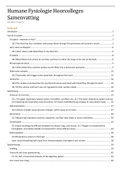Humane Fysiologie Hoorcolleges
Samenvatting
Annabel Couzijn
Inhoud
Introductie ........................................................................................................................................................................ 3
Hart & Circulatie................................................................................................................................................................ 3
Circulatie – waarom en hoe? ........................................................................................................................................ 3
18.1 The heart has four chambers and pumps blood through the pulmonary and systemic circuits ...................... 3
Hart, vaten en kleppen ................................................................................................................................................. 6
18.2 Heart valves make blood flow in one direction ................................................................................................ 6
Circulatie ....................................................................................................................................................................... 8
18.3 Blood flows from atrium to ventricle, and then to either the lungs or the rest of the body ........................... 8
Microscopische bouw ................................................................................................................................................... 9
18.4 Intercalated discs connect cardiac muscle fibers into a functional syncytium ................................................. 9
Elektrische activatie .................................................................................................................................................... 10
18.5 Pacemaker cells trigger action potentials throughout the heart.................................................................... 10
Hartcyclus.................................................................................................................................................................... 16
18.6 The cardiac cycle describes the mechanical events associated with blood flow through the heart.............. 16
18.7 Stroke volume and heart rate are regulated to alter cardiac output ............................................................. 18
Ademhaling ..................................................................................................................................................................... 19
Structuur en functiue .................................................................................................................................................. 19
22.1 The upper respiratory system warms, humidifies, and filters air; 22.2 The lower respiratory system consists
of conducting and respiratory zone structures; 22.3 Each multilobed lung occupies its own pleural cavity ........ 19
Ademmechanica ......................................................................................................................................................... 27
22.4 Volume changes cause pressure changes, which cause air to move.............................................................. 27
Spirometrie ................................................................................................................................................................. 30
22.5 Measuring respiratory volumes, capacities, and flow rates helps us assess ventilation ................................ 30
Gastransport ............................................................................................................................................................... 34
22.6 Gases exchange by diffusion between the blood, lungs, and tissues; 22.7 Oxygen is transported by
hemoglobin, and carbon dioxide is transported in three different ways ............................................................... 34
Ademregulatie............................................................................................................................................................. 38
22.8 Respiratory centers in the brain ..................................................................................................................... 38
stem control breathing with input from chemoreceptors and higher brain centers ............................................. 38
Spijsvertering .................................................................................................................................................................. 39
Voeding ....................................................................................................................................................................... 39
Overzicht van onze spijsvertering ............................................................................................................................... 45
Ch. 23, Part 2 Functional anatomy of the digestive system ................................................................................... 45
Van mond naar maag .................................................................................................................................................. 46
, 23.4 Ingestion occurs only at the mouth; 23.5 The pharynx and esophagus move food from the mouth to the
stomach................................................................................................................................................................... 46
In de maag................................................................................................................................................................... 47
23.6 The stomach temporarily stores food and begins protein digestion.............................................................. 47
Dunne darm ................................................................................................................................................................ 50
23.7 The liver secretes bile; the pancreas secretes digestive enzymes; 23.8 The small intestine is the major site
for digestion and absorption; 23.11 How is each type of nutrient processed?...................................................... 50
Dikke darm .................................................................................................................................................................. 56
23.9 The large intestine absorbs water and eliminates feces ................................................................................ 56
Nieren.............................................................................................................................................................................. 58
Functie van de nieren ................................................................................................................................................. 58
Structuur ..................................................................................................................................................................... 59
25.1 The kidneys have three distinct regions and a rich blood supply ................................................................... 59
Het nefron ................................................................................................................................................................... 61
25.2 Nephrons are the functional units of the kidney ............................................................................................ 61
Filtratie, reabsorptie en secretie................................................................................................................................. 61
25.3 Overview: Filtration, absorption, and secretion are the key processes of urine formation........................... 61
Filtratie ........................................................................................................................................................................ 62
25.4 Urine formation, step 1: The glomeruli make filtrate ..................................................................................... 62
Reabsorptie ................................................................................................................................................................. 63
25.5 Urine formation, step 2: Most of the filtrate is reabsorbed into the blood ................................................... 63
Secretie ....................................................................................................................................................................... 68
25.6 Urine formation, step 3: Certain substances are secreted into the filtrate.................................................... 68
Osmoregulatie............................................................................................................................................................. 68
25.7 The kidneys create and use an osmotic gradient to regulate urine concentration and volume .................... 68
Nierfunctie .................................................................................................................................................................. 69
25.8 Renal function is evaluated by analyzing blood and urine ............................................................................. 69
Afvoer .......................................................................................................................................................................... 69
25.9 The ureters, bladder, and urethra transport, store, and eliminate urine....................................................... 69
,Introductie
❖ Doel: inleiding tot de humane fysiologie buiten de neurofysiologie
❖ Vier onderwerpen:
➢ Hart & circulatie
➢ Ademhaling
➢ Spijsvertering
➢ Nieren
Hart & Circulatie
Circulatie – waarom en hoe?
18.1 The heart has four chambers and pumps blood through the pulmonary and systemic circuits
❖ We bestaan voor 50-50% uit lichaamsvoch, 42 L
➢ Cell fluid (ICF) en extracellulaire fluid (ECF)
▪ Extracellulaire fluid bestaat uit plasma en interstitual fluid
❖ Plasma: 55% van bloed volume, overige van bloed is rode
bloedcellen, witte bloedcellen en plaatjes
❖ ICF bestaat vooral uit kalium
❖ interstitual en plasma bestaat vooral uit natrium
❖
❖ verschil plasma en interstitieel: eiwitten kunnen bloedvaten niet uit dus plasma heeft meer eiwit
❖ Concentraties opbouw vloeistoffen: ->
, ➢ Is net anders voor tweewaardig ion zoals
calcium:
▪ Deze tabel is in mEq (mii equivalent, een
maat voor de lading, niet voor
concentratie))
▪ 2.5 mmol/L aan Ca2+ geeft 5.0 mEq/L aan
lading
❖ ICF loost zijn afvalstoffen en warmte op ECF
❖ Interstitiele vloeistof loost dat weer op plasma
❖ Voedingstoffen gaan van plasma naar interstitieel
naar intercellulair
❖
❖ Hoe blijft het milieu intérieur (= ECF) op peil?
➢ Circulatie! (met alle regelmechanismen daaromheen)
❖ Het hart is een dubbele pomp
➢ kleine circulatie (‘pulmonale circulatie’)
▪ longen
➢ grote circulatie (‘systemische circulatie’)
▪ overige organen
❖ De twee pompen zijn in serie geschakeld
❖ Functies van circulatie van bloed
➢ Transport
▪ voedingsstoffen, afvalstoffen
▪ cellulaire producten (hormonen, antistoffen)
▪ gassen (O2, CO2)
➢ Regulatie
▪ lichaamstemperatuur
▪ pH-waarde en osmotische balans
➢ Bescherming
▪ tegen bloedverlies (stelping en stolling)
▪ tegen indringers (witte bloedcellen, antilichamen)
❖ Grote circulatie
➢ hogedruksysteem
➢ lokale perfusie van organen
➢ aanvoeren voldoende zuurstof
➢ aanvoeren voldoende voedingsstoffen
❖ Kleine circulatie
➢ lagedruksysteem
➢ oxygenatie bloed
➢ verwijdering CO2
❖ Waar stroomt ons bloed heen?
➢ ‘Rest and Digest’: meeste naar spieren, nieren,
adbomen organen. Circulatie 5 L / min
➢ ‘Fight or Flight’: veel naar spieren en huid. Circultie
17.5 L/min






